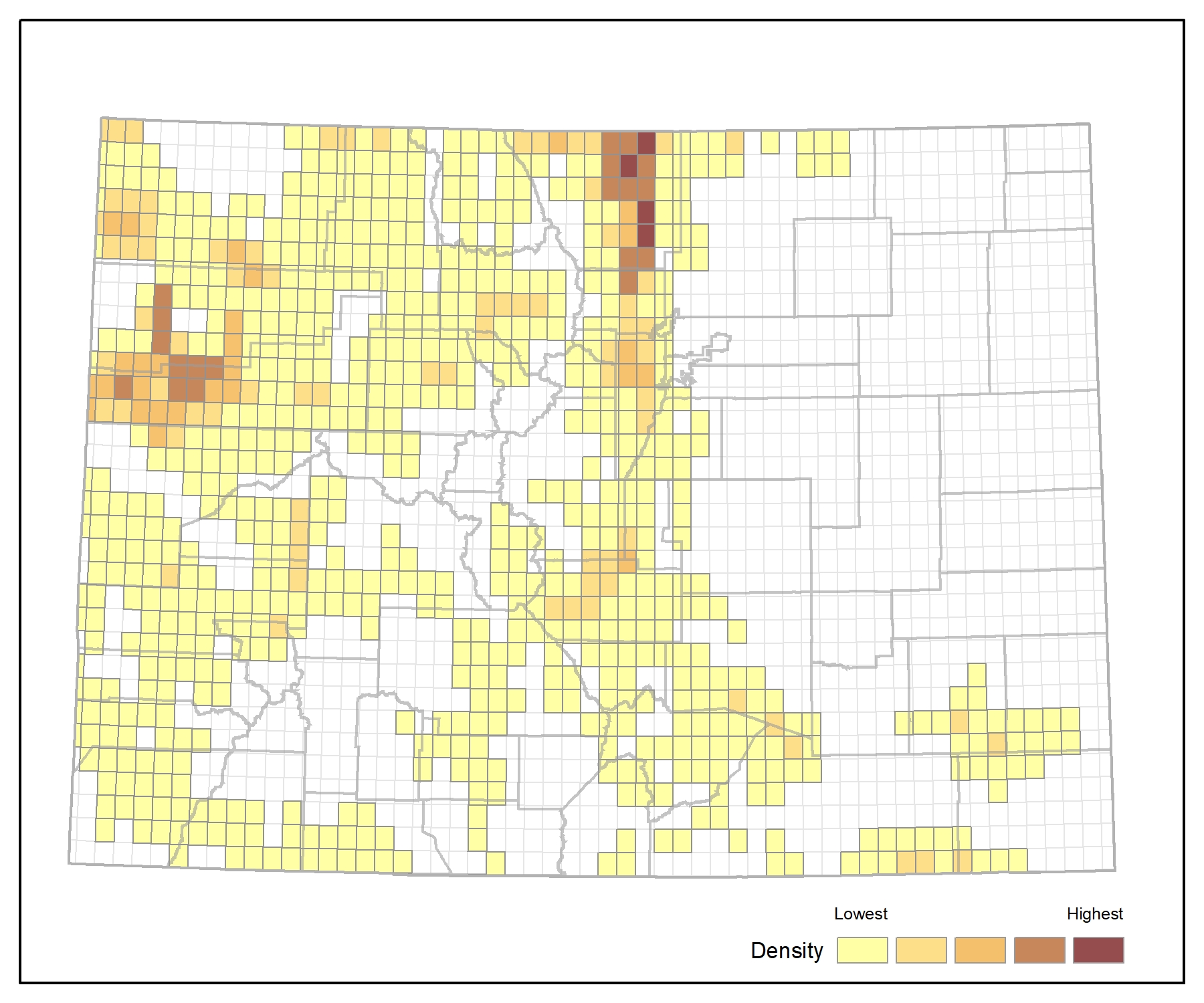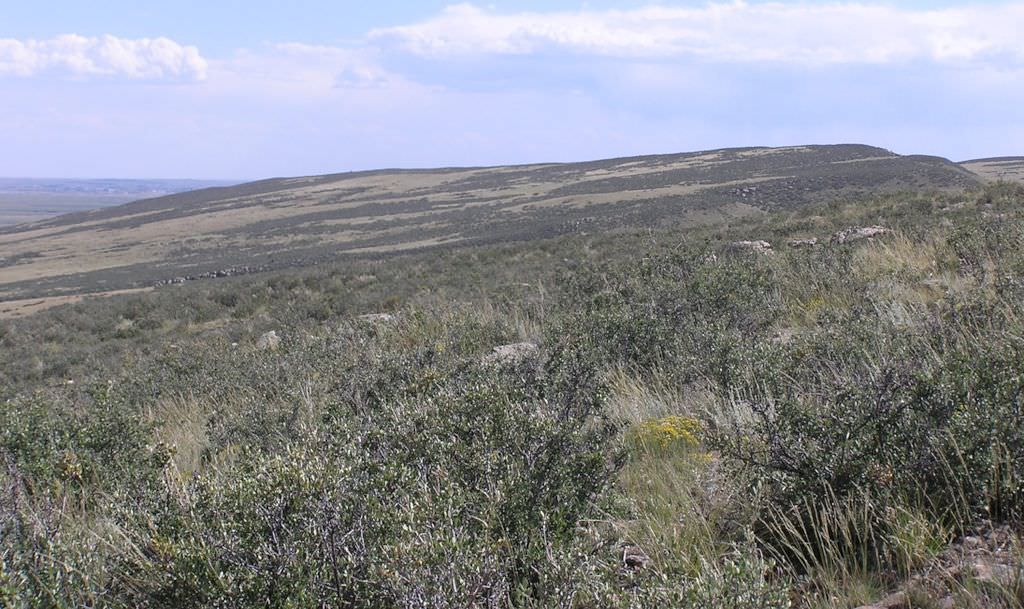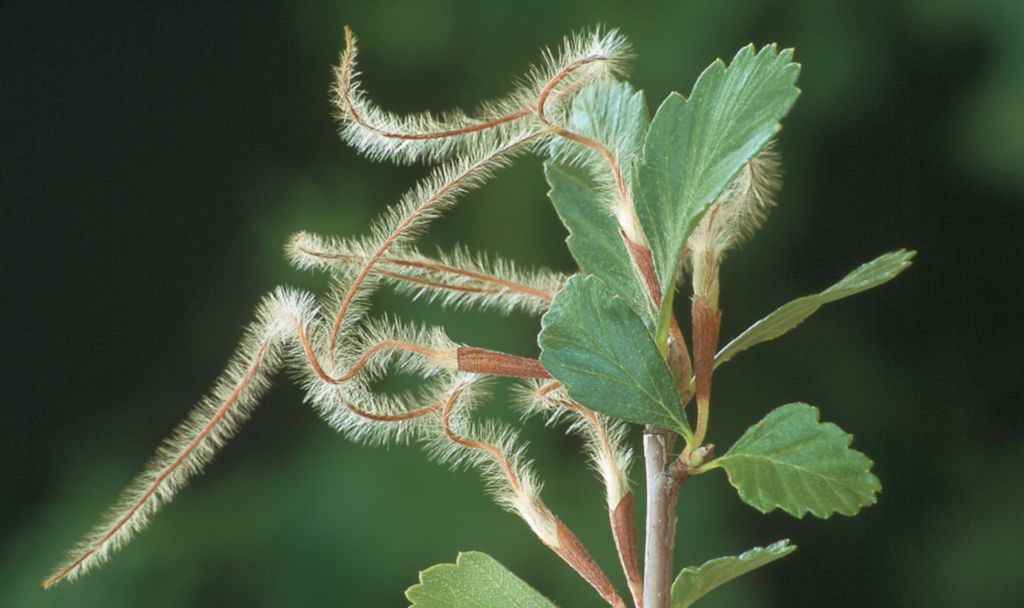Rocky Mountain Lower Montane-Foothill Shrubland
Click link below for details.
General Description
This ecological system is found in the foothills, canyon slopes and lower montane of the Rocky Mountains and ranges from southern New Mexico extending north into Wyoming, and west into the Intermountain region. In Colorado these shrublands are most common in the northern portion of the state especially on dry foothills, ridges, and basins of the northern Colorado Front Range. Elevations range from 1,490 to 2,590 m (4,900 to 8,500 ft). The component associations typically form a patchy mosaic of shrub communities that can change noticeably across short geographic distances and are, as well, often transitional between plains systems and montane systems. In general, these are mixed shrublands of areas where Gambel oak (Quercus gambelii) is absent, although they may intergrade in places with oak/mixed mountain shrublands. Occurrences of this system are dominated by low to moderate height shrubs averaging 1-2 m in height. The herbaceous stratum rarely exceeds 1m in height. Scattered trees or inclusions of grassland patches or steppe may be present, but the vegetation is typically dominated by a variety of shrubs including mountain mahogany (Cercocarpus montanus), antelope bitterbrush (Purshia tridentata), chokecherry (Prunus virginiana), skunkbush sumac (Rhus trilobata), wax currant (Ribes cereum), mountain ninebark (Physocarpus monogynus), or soapweed yucca (Yucca glauca). Understory grass species vary with site conditions; common species include mountain muhly (Muhlenbergia montana), blue grama (Bouteloua gracilis), sideoats grama (Bouteloua curtipendula), Arizona fescue (Festuca arizonica), needle-and-thread (Hesperostipa comata), and bluebunch wheatgrass (Pseudoroegneria spicata). Scattered individuals of Rocky Mountain juniper (Juniperus scopulorum), ponderosa pine (Pinus ponderosa), or other conifers may be present.
Diagnostic Characteristics
These foothill and lower montane shrublands are often transitional between grassland or shrubland types and savanna or forest ecosystems.
Similar Systems
Range
Rocky Mountain Lower Montane-Foothill Shrublands occur in the foothills, canyon slopes and dry lower montane of the Rocky Mountains and ranges from southern New Mexico extending north into Wyoming, and west into the Intermountain region. In Colorado these shrublands are most common in the northern portion of the state especially on dry foothills, ridges, and basins of the northern Colorado Front Range.
Ecological System Distribution

Spatial Pattern
Rocky Mountain Lower Montane-Foothill Shrublands are generally a large patch type in Colorado, although some very large occurrences are found in the northern Front Range.
Environment
These shrublands occur in the foothills, ridges, canyon slopes and lower mountains of the Rocky Mountains and on outcrops, mesas, and canyon slopes in the western Great Plains, at elevations between 1,490 and 2,590 m (4,900 to 8,500 ft). In general, these are mixed shrublands of areas where oak is absent, although they may intergrade in places with oak/mixed mountain shrublands, such as at the northern extent of Gambel oak along the mountain front in Colorado, or with other Quercus species on the Mesa de Maya. Although this system is often associated with exposed sites, rocky substrates, and dry conditions which limit tree growth, the principle species characterizing these shrublands form associations that range from xeric to mesic. The component associations typically form a patchy mosaic of shrub communities that can change noticeably across short geographic distances and are, as well, often transitional between plains systems and montane systems. In general, temperature decreases and precipitation increases with altitude, resulting in a foothill and lower montane habitat that is appreciably more mesic than that of the adjacent plains These shrublands appear to be environmentally intermediate between grasslands and savanna/forest associations, being drier than the latter, and moister than the former.
Vegetation
Communities of this system are diverse, and species composition varies with elevation, aspect, soils, and disturbance history. Only a few of the component associations have a widespread distribution; many are restricted to a relatively small portion of the range. Communities range from xeric to mesic, and may be transitional to riparian woodland and shrublands. The dominant shrub species are generally well adapted to poor soils, dry sites, and disturbance by fire. Association of this system are dominated by low to moderate height shrubs averaging 1-2 m in height. The herbaceous stratum rarely exceeds 1m in height. Scattered trees or inclusions of grassland patches or steppe may be present, but the vegetation is typically dominated by a variety of shrubs including mountain mahogany (Cercocarpus montanus), antelope bitterbrush (Purshia tridentata), skunkbush sumac (Rhus trilobata), wax currant (Ribes cereum), mountain ninebark (Physocarpus monogynus), serviceberry (Amelanchier spp.) or soapweed yucca (Yucca glauca). Many of the dominant shrub species are also members of the shrub layer in ponderosa or mixed conifer woodlands.
Understory grass species vary with site conditions, and include species of both plains and montane. Common species include mountain muhly (Muhlenbergia montana), blue grama (Bouteloua gracilis), sideoats grama (Bouteloua curtipendula), Arizona fescue (Festuca arizonica), needle-and-thread (Hesperostipa comata), and bluebunch wheatgrass (Pseudoroegneria spicata). Other graminoids that may be present include Indian ricegrass (Achnatherum hymenoides), threeawn (Aristida spp.), sedge (Carex spp.), squirreltail (Elymus elymoides), slender wheatgrass (Elymus trachycaulus), prairie Junegrass (Koeleria macrantha), spike fescue (Leucopoa kingii), slimstem muhly (Muhlenbergia filiculmis), and little bluestem (Schizachyrium scoparium). The introduced grasses cheatgrass (Bromus tectorum), smooth brome (B. inermis), and Kentucky bluegrass (Poa pratensis) are often present. Forbs and dwarf-shrubs generally have low cover. Typical forbs include common yarrow (Achillea millefolium), pussytoes (Antennaria spp.), textile onion (Allium textile), white sagebrush (Artemisia ludoviciana), milkvetech (Astragalus spp.), sulphur-flower buckwheat (Eriogonum umbellatum), shaggy fleabane (Erigeron pumilus), little sunflower (Helianthus pumilus), hairy false goldenaster (Heterotheca villosa), mountain bladderpod (Lesquerella montana), prairie bluebells (Mertensia lanceolata), plains pricklypear (Opuntia polyacantha), and cinquefoil (Potentilla spp.), among others. Scattered individuals of Rocky Mountain juniper (Juniperus scopulorum), ponderosa pine (Pinus ponderosa), or other conifers may be present.
- CEGL001070 Amelanchier (utahensis, alnifolia) - Cercocarpus montanus Shrubland
- CEGL001069 Amelanchier utahensis / Pseudoroegneria spicata Shrubland
- CEGL001067 Amelanchier utahensis Shrubland
- CEGL002782 Artemisia frigida / Bouteloua gracilis Dwarf-shrubland
- CEGL001421 Artemisia nova / Leymus salinus Shrub Grassland
- CEGL005805 Cercocarpus montanus - Artemisia tridentata Shrubland
- CEGL003820 Cercocarpus montanus - Fendlera rupicola Shrubland
- CEGL002912 Cercocarpus montanus - Rhus trilobata / Andropogon gerardii Shrubland
- CEGL002913 Cercocarpus montanus / Achnatherum scribneri Shrubland
- CEGL001086 Cercocarpus montanus / Bouteloua curtipendula Shrubland
- CEGL001087 Cercocarpus montanus / Elymus lanceolatus ssp. lanceolatus Shrubland
- CEGL001092 Cercocarpus montanus / Hesperostipa comata Shrubland
- CEGL002911 Cercocarpus montanus / Hesperostipa neomexicana Shrubland
- CEGL002914 Cercocarpus montanus / Muhlenbergia montana Shrubland
- CEGL001090 Cercocarpus montanus / Pseudoroegneria spicata Shrubland
- CEGL001091 Cercocarpus montanus / Rhus trilobata Shrubland
- CEGL001108 Prunus virginiana - (Prunus americana) Wet Shrubland
- CEGL001055 Purshia tridentata / Artemisia frigida / Hesperostipa comata Shrubland
- CEGL001057 Purshia tridentata / Muhlenbergia montana Shrubland
- CEGL002910 Rhus trilobata Rocky Mountain Shrubland
- CEGL001124 Ribes cereum / Leymus ambiguus Shrubland
- CEGL001131 Symphoricarpos occidentalis Shrubland
- CEGL002951 Symphoricarpos oreophilus Shrubland
Associated Animal Species
Shrub communities of this system can provide important seasonal food and cover for wildlife at critical times of the year. Mammals using these shrublands include pronghorn (Antilocapra americana), mule deer (Odocoileus hemionus), elk (Cervus elaphus), bighorn sheep (Ovis canadensis), black bear (Ursus americanus), mountain lion (Felis concolor), bobcat (Felis rufus), and numerous smaller species. Typical bird species include Virginia's Warbler (Oreothlypis virginiae), Spotted Towhee (Pipilo maculatus), Green-tailed Towhee (Pipilo chlorurus), Broad-tailed Hummingbird (Selasphorus platycercus), MacGillivray's Warbler (Geothlypis tolmiei), Dusky Flycatcher (Empidonax oberholseri), and Blue-gray Gnatcatcher (Polioptila caerulea). Fence lizards (Sceloporus spp.) and Prairie rattlesnake (Crotalus viridis) are also found in these shrublands.
Dynamic Processes
Fire is a naturally occurring process in lower montane and foothill shrublands, but the system is not always fire-driven. Fire suppression may have allowed an invasion of trees into some of these shrublands, but in many cases sites are too dry to allow much tree growth, even in the absence of fire. With the exception of antelope bitterbrush (Purshia tridentata), the dominant shrubs are generally able to survive fire and resprout vigorously after being top-killed. Variation in response to fire within and between species may gradually change the composition of a shrubland. Repeated fires may greatly decrease shrub abundance. Fire regimes in this type are probably naturally variable, depending on local site factors. Fire can greatly increase available soil nutrients in this system, although erosion potential also increases in burned areas.
Lower montane and foothill shrublands evolved with a variety of native browsers and grazers, and dominant shrubs in these shrublands are generally palatable to browsing animals, and are tolerant of herbiverory at moderate levels. Herbivory affects energy and material flow in the system, but may also have differential impacts on life history stages of species. Some species are able to compensate for annual growth lost to herbivory, at least under conditions of high resource availibility. However, unbrowsed shrubs produced many more flowers and seeds than browsed shrubs.
Management
Land use within the lower montane and foothills shrublands as well as in adjacent areas can fragment the landscape and reduce connectivity between patches and between occurrences and the surrounding landscape. In the Colorado Front Range, many of these habitats are in areas that are highly desirable for suburban or exurban development, roads, or recreational infrastructure. Other occurrences of this system along the mountain front are found on public (open space) lands where recreational use can be a major source of disturbance, with a concomitant increase in weedy exotic species.
References
- Geist, J.M. 1965. Site-vegetation relationships in the montane zone of northern Colorado. Unpublished thesis, Colorado State University, Fort Collins, Colorado. 104 pp.
- Ramaley, F. 1931. Vegetation of chaparrel covered foothills southwest of Denver, Colorado. University of Colorado Studies 18:231-237.
- Robbins, W.W. 1908. Studies of mesa and foothill vegetation. 4. Distribution of the deciduous trees and shrub on the mesas. University of Colorado Studies 6:36-49.
- Rogers, C. M. 1950. The vegetation of the Mesa de Maya region of Colorado, New Mexico, and Oklahoma. Unpublished dissertation, University of Michigan, Ann Arbor. 125 pp.
- Turley, D., B.A. Roundy, and S.C. Walker. 2003. Growth and reproductive responses of true mountain mahogany to browsing. Journal of Range Management 56:591-599.
- Vestal, A.G. 1917. Foothills vegetation in the Colorado Rocky Mountain Front. Botanical Gazette 64:353-385.
- Vestal, A.G. 1919. Phytogeography of the eastern mountain front in Colorado. I. Physical geography and distribution of vegetation. Botanical Gazette 68:153-193.
- Whitfield, C.J. 1933. The vegetation of the Pikes Peak region. Ecological Monographs 3: 75-105
- Brotherson J.D., D.L. Anderson, and L.A. Szyska. 1984. Habitat relations of Cercocarpus montanus (true mountain mahogany) in central Utah. Journal of Range Management 37(4): 321-324.









